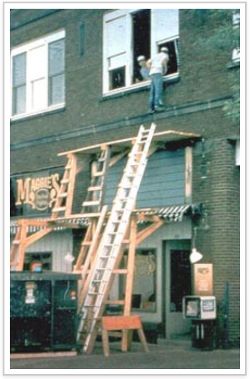Shore or Lean-to Scaffolds
Shore or lean-to scaffolds are prohibited by OSHA 29 CFR 1926.451(f)(2) because they put workers at serious risk of falls, structural collapse, or injury from falling materials.
This regulation makes it clear that these types of scaffolds must never be used under any circumstances due to their unsafe and non-compliant construction. These makeshift scaffolds are often assembled using unstable or improvised supports such as building walls, scrap wood, or unsecured materials.
For example, the image shows an improperly supported multiple-level lean-to scaffold where a worker is seen climbing into a second-floor window. This setup lacks proper anchoring, bracing, and load-bearing design, making it extremely unsafe. Without proper engineering and inspection, these scaffolds can shift, tip over, or collapse under weight, especially when subjected to weather changes or vibrations from work activities.
The use of such scaffolds puts workers at serious risk of falls, structural collapse, or injury from falling materials. OSHA standards (29 CFR 1926 Subpart L) require that all scaffolds be designed and constructed under the supervision of a qualified person and built to support their intended load. Lean-to scaffolds fail to meet these basic safety criteria and must never be used on any job site.
These types of scaffolds often rely on unstable supports like building walls or loose materials, which can easily shift or collapse. Their poor construction makes them a serious safety hazard to anyone working on or near them.
Storms and High Winds
According to OSHA 29 CFR 1926.451(f)(12), working on scaffolds during storms or high winds is strictly prohibited unless a competent person has inspected the scaffold and confirmed it is safe.
In such cases, workers must be protected by personal fall-arrest systems or properly installed wind screens to reduce the risk of injury or death. Wind screens shall not be used unless the scaffold is secured against the anticipated wind forces imposed.
Scaffold Collapse
Scaffolds are especially vulnerable during severe weather. In an incident in Britain, shown in the video, a scaffold collapsed due to high winds. Fortunately, no workers were on the scaffold at the time.
Working on scaffolds when lightning storms are in the area is strictly prohibited due to the serious risk of electrocution. Scaffolds are often made of metal, which can easily conduct electricity if struck by lightning. work on scaffolds must be suspended and not resumed until the storm has passed and it is safe to continue.
If lightning is observed nearby or storm warnings are issued, all scaffold work must stop immediately. Workers must evacuate the scaffold and seek shelter in a safe location away from metal structures and exposed areas until the threat is over. Following these rules helps protect workers from potentially fatal injuries caused by lightning strikes.
Knowledge Check Choose the best answer for the question.
1-8. Why is working on shore or lean-to scaffolds strictly prohibited under any circumstance?
You forgot to answer the question!

